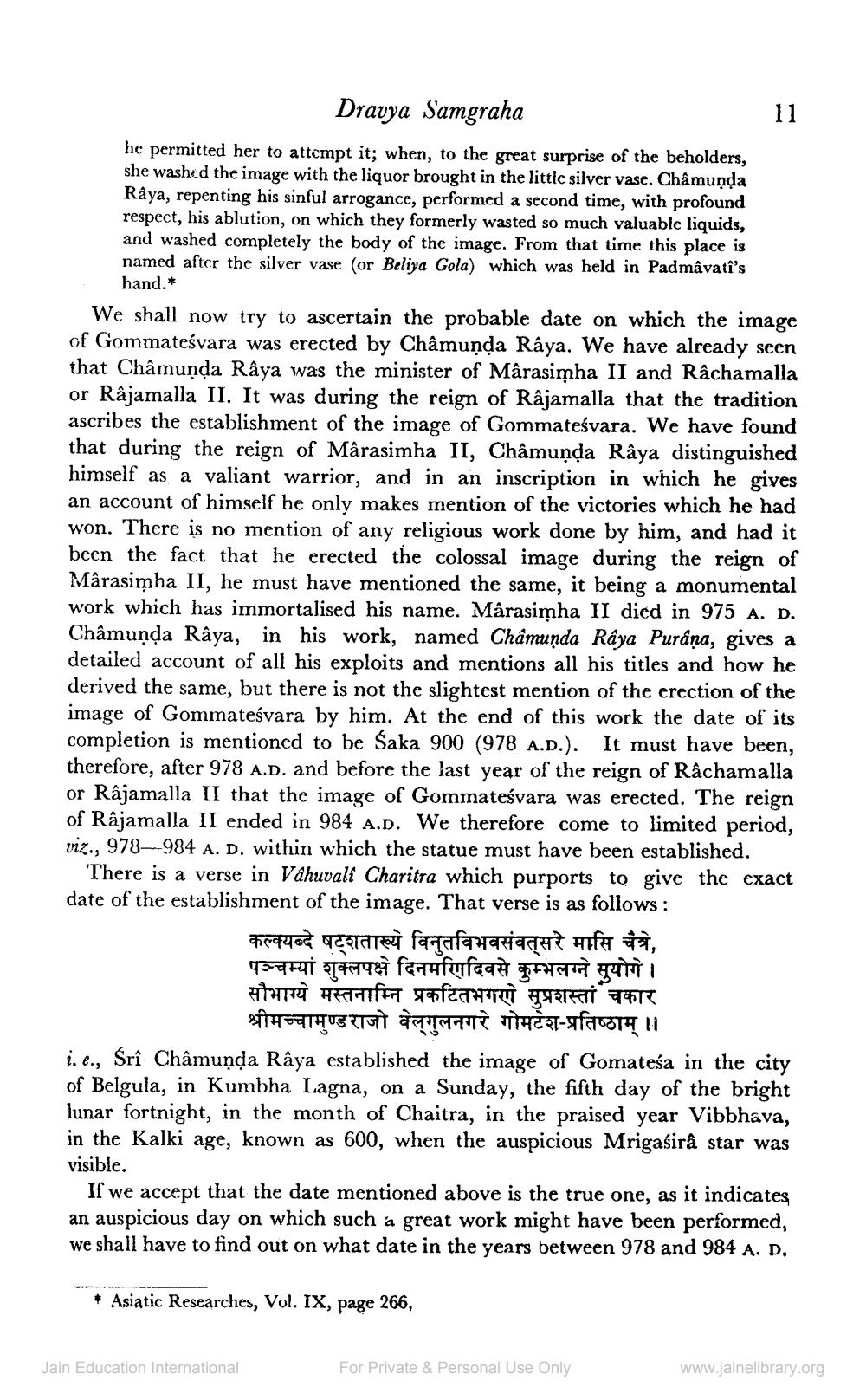________________
Dravya Samgraha
11 he permitted her to attempt it; when, to the great surprise of the beholders, she washed the image with the liquor brought in the little silver vase. Châmunda Râya, repenting his sinful arrogance, performed a second time, with profound respect, his ablution, on which they formerly wasted so much valuable liquids, and washed completely the body of the image. From that time this place is named after the silver vase (or Beliya Gola) which was held in Padmavati's
hand. We shall now try to ascertain the probable date on which the image of Gommateśvara was erected by Châmunda Raya. We have already seen that Châmunda Râya was the minister of Marasimha II and Râchamalla or Râjamalla II. It was during the reign of Rajamalla that the tradition ascribes the establishment of the image of Gommateśvara. We have found that during the reign of Mârasimha II, Châmunda Râya distinguished himself as a valiant warrior, and in an inscription in which he gives an account of himself he only makes mention of the victories which he had won. There is no mention of any religious work done by him, and had it been the fact that he erected the colossal image during the reign of Mârasimha II, he must have mentioned the same, it being a monumental work which has immortalised his name. Mârasimha II died in 975 A. D. Châmunda Raya, in his work, named Chamunda Raya Purana, gives a detailed account of all his exploits and mentions all his titles and how he derived the same, but there is not the slightest mention of the erection of the image of Gommateśvara by him. At the end of this work the date of its completion is mentioned to be Saka 900 (978 A.D.). It must have been, therefore, after 978 A.D. and before the last year of the reign of Râchamalla or Rajamalla II that the image of Gommateśvara was erected. The reign of Rajamalla II ended in 984 A.D. We therefore come to limited period, viz., 978-984 A. D. within which the statue must have been established.
There is a verse in Vahuvalí Charitra which purports to give the exact date of the establishment of the image. That verse is as follows:
कल्क्यब्दे षट्शताख्य विनुतविभवसंवत्सरे मासि चैत्रे, पञ्चम्यां शुक्लपक्षे दिनमरिणदिवसे कुम्भलग्ने सुयोगे। सौभाग्य मस्तनाम्नि प्रकटितभगणे सुप्रशस्तां चकार
श्रीमच्चामुण्डराजो वेल्गुलनगरे गोमटेश-प्रतिष्ठाम् ।। i. e., Śrî Châmunda Râya established the image of Gomateśa in the city of Belgula, in Kumbha Lagna, on a Sunday, the fifth day of the bright lunar fortnight, in the month of Chaitra, in the praised year Vibbhava, in the Kalki age, known as 600, when the auspicious Mrigasirâ star was visible.
If we accept that the date mentioned above is the true one, as it indicates an auspicious day on which such a great work might have been performed, we shall have to find out on what date in the years between 978 and 984 A. D.
* Asiatic Researches, Vol. IX, page 266,
Jain Education International
For Private & Personal Use Only
www.jainelibrary.org




